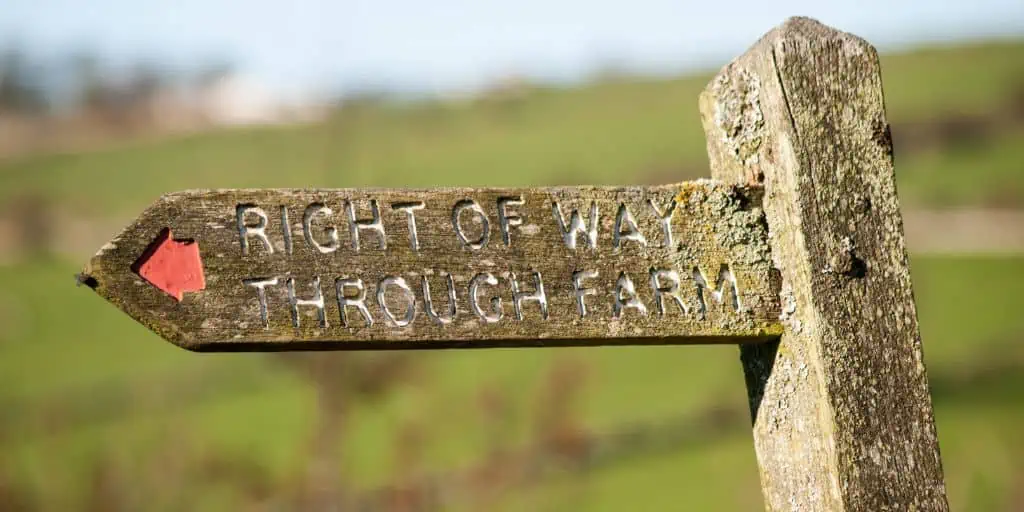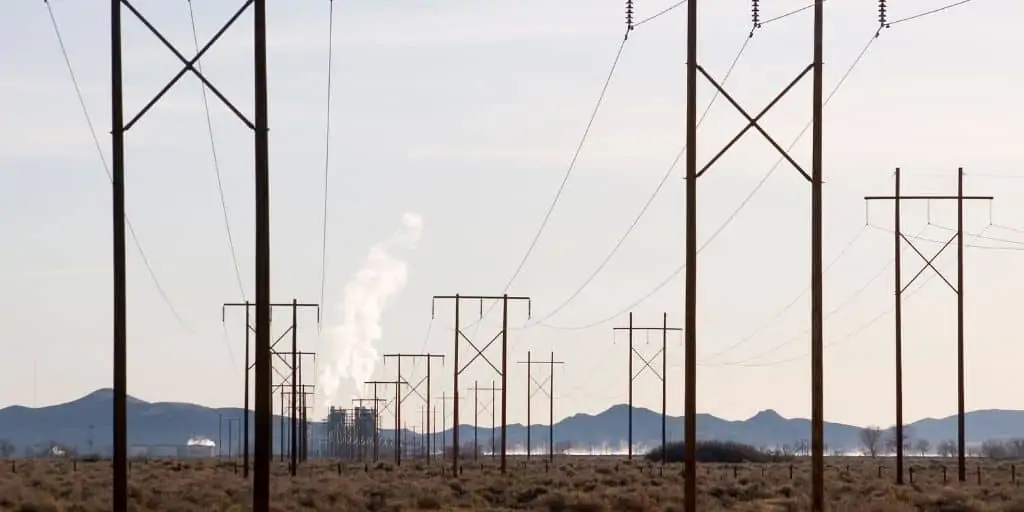What Is Right-of-Way?
REtipster does not provide legal advice. The information in this article can be impacted by many unique variables. Always consult with a qualified legal professional before taking action.
Shortcuts
- Right-of-way (ROW) is the legal right to pass through or use someone else’s property for public or private use.
- A right-of-way is commonly considered a type of easement in real estate.
- Public bodies can acquire rights-of-way through purchase, condemnation, or eminent domain.
- There are two main types of ROWs: public rights-of-way for general access and private easements for specific uses.
- Rights-of-way can be established or terminated through different legal means, including written agreements, court orders, or long-term use.
Understanding Right-of-Way
Right-of-way (ROW) is a legal term that refers to the legal right to pass through or use someone else’s property for public and/or private use. This makes a right-of-way an important legal consideration, especially when purchasing real estate or constructing infrastructure projects.
In real estate, a right-of-way is a type of easement where someone can pass through property owned by another. A right-of-way can impact usable land area and permitted development, so properties with easements often have some restrictions[1].
A right-of-way ensures that necessary access is provided to properties that may otherwise be landlocked or lack convenient access to public roads, utilities, or other essential services.
Right-of-Way vs. Easement
“Right-of-way” and “easement” are legal terms that talk about who can use a portion of someone’s land and for what reason, but with some key differences.
- Right-of-way: This usually means someone has permission to pass through another person’s property, like a path or a road that cuts through someone’s land. Most rights-of-way aren’t just for the owner but for others as well. It could be for walking, driving, or even for things like power lines.
- Easement: An easement gives someone the right to use, but not to own, a part of another person’s land for a particular reason, like for utilities, or even as access, such as a right-of-way. An easement isn’t always open for everyone; for example, it can just be for one person or company.
In a nutshell, a right-of-way is an easement, but not all easements are rights-of-way.
Acquiring Rights-of-Way
A public body can acquire a right-of-way through purchase, condemnation, or eminent domain. The Uniform Act of 1970 outlines the process and requirements for obtaining a right-of-way for federal agencies[2]. Otherwise, deed covenants and easements can also establish a right-of-way.
When dealing with a right-of-way, it’s a good idea to observe the following:
- Identify all ROWs in property records before purchase to avoid surprises later.
- Mark right-of-way boundaries to prevent boundary disputes with neighbors.
- Follow permitted usage stipulated in the establishing easement documents.
- Maintain ROWs as required per any applicable agreements for continued access rights.
- Cooperate with maintenance, repair, or improvement work within a right-of-way.
Types of Rights-of-Way
There are two main types of rights-of-way: public rights-of-way and private easements.
Public Rights-of-Way
Public rights-of-way provide access to properties and the public for transportation purposes like roads, bike paths, and foot trails. A public entity like a city, county, or state generally maintains them.
Examples include roads, sidewalks, highways, bridges, and alleys. Property owners retain land ownership but must allow public access[3].
Private Easements
Private easements give you nonpossessory rights[4] to use or access someone else’s land for a specific, limited purpose. They can be established through an express grant, a reservation in a deed, or historical/prescriptive rights from prior continuous use over a long time, generally five years or more[5], depending on state laws. This type of easement is called a prescriptive easement or easement by adverse possession.
Utilities, access roads, and drainage ditches are typical uses for private easements that benefit a particular person(s) rather than the general public.
Legal Considerations for Right-of-Way
Understanding the legal aspects of a right-of-way is essential for property owners and those seeking access to properties. Here are a few key legal considerations:
Creation and Termination
A right-of-way can be established through various means, including written agreements, court orders, or prescription (long-term use without legal permission).
A right-of-way easement can also be terminated or extinguished under specific circumstances[6], such as abandonment, expiration of the agreed-upon term, or when the purpose for which it was granted no longer exists.
Rights and Responsibilities
A right-of-way grants specific rights to the party benefiting from it, such as the right to enter and exit the property and perform necessary maintenance activities.
However, it also comes with responsibilities, such as the obligation to maintain the right-of-way and ensure that it doesn’t unreasonably interfere with the rights of the property owner.
Disputes and Resolutions
Disputes regarding a right-of-way can arise between property owners, beneficiaries, or government entities. In such cases, legal remedies, such as mediation, arbitration, or litigation, may be pursued to resolve conflicts and ensure fair and equitable access.
Practical Considerations for Right-of-Way
Rights-of-way play a crucial role in property development and planning. Here are some practical considerations:
- Access to public utilities: A right-of-way allows utility companies to install and maintain necessary infrastructure, such as power lines, water pipes, or fiber optic cables. Property owners must consider the impact of these installations and ensure that adequate access is provided.
- Subdivision and land development: When subdividing land or developing a property, it is essential to consider right-of-way requirements. Local zoning and planning regulations may dictate the minimum width and location of access points to ensure safe and efficient traffic flow.
- Property boundary determination: The right-of-way may impact property boundaries, especially if it overlaps or encroaches upon neighboring properties. Proper boundary surveys and consultations with legal professionals are crucial to avoid boundary disputes.
- Tax assessments: Some jurisdictions may assess property taxes differently when a right-of-way is involved. Generally speaking, if a portion of your property is under an easement for public use or utility access, that could lower the value of your property[7] and thus your taxes. Conversely, if you’re granted an easement that allows you access to essential services or roads, that could increase your property’s value and, therefore, your taxes.
RELATED: The Truth About Land Investing: 21 Point Due Diligence Checklist For Buying Vacant Land
Frequently Asked Questions: Right-of-Way
Can a right-of-way be abandoned, moved, or transferred?
It depends on the original easement agreement, but you usually need permission or a court order to remove a ROW or change its boundaries. Simply not using it doesn’t necessarily eliminate the underlying legal right of access.
In addition, a right-of-way easement often “runs with the land,” which means the restrictions and provisions of the easement transfer to another owner when sold (subject to legal requirements and the consent of all parties involved)[8]. Transferring a right-of-way typically involves a formal legal process, such as executing a new agreement or amending an existing one, to ensure the transfer is valid and legally binding.
What happens if someone builds in a right-of-way?
Any permanent structure erected within a ROW is considered an encroachment, resulting in costly removal requirements or legal action to protect the established access right (i.e., demolishing the structure built on the easement)[9]. It’s best to research ROWs beforehand to avoid such issues.
To determine if a property has a right-of-way, conduct a thorough title search and review the property’s deed, plat maps, and existing easement agreements. Consulting a qualified real estate attorney or a professional surveyor can provide valuable insights and help clarify any existing rights or restrictions.
Can a property owner control public access along a right-of-way?
In most cases, no. Private landowners cannot legally restrict rights-of-way established for public transportation purposes like roads. However, control over usage like parking and maintenance may reside with the jurisdiction.
Some states may provide exceptions. For example, Wisconsin allows the property owner to erect fences across a right-of-way or use the right-of-way for purposes that don’t obstruct the right-of-way operations, such as an electric line[10]. Consult your local state board for details regarding public use and landowner’s rights on right-of-way.
Sources
- DeLoe, R. (2023, May 11.) How does an easement affect you and your property? LegalZoom. Retrieved from https://www.legalzoom.com/articles/how-does-an-easement-affect-you-and-your-property
- Federal Highway Administration. (2012, August.) Introduction to Right-of-Way Requirements and the Uniform Act. Department of Transportation. Retrieved from https://www.fhwa.dot.gov/federal-aidessentials/companionresources/06rowuniformact.pdf
- Meinig, B. (2014, January 2.) What is the Nature of a Public Right-of-Way? Municipal Research and Services Center of Washington. Retrieved from https://mrsc.org/stay-informed/mrsc-insight/january-2014/what-is-the-nature-of-a-public-right-of-way
- Folger, J. (2021, August 25.) Encumbrances and Nonpossessory Interests In Real Property. Investopedia. Retrieved from https://www.investopedia.com/articles/mortgages-real-estate/12/encumbrances-nonpossessory-interests.asp
- Prescriptive Easements – Obtaining Rights In Land By Use. (n.d.) Law Offices of Stimmel, Stimmel & Roeser. Retrieved from https://www.stimmel-law.com/en/articles/prescriptive-easements-obtaining-rights-land-use
- Sandvick, C. (2022, December 24.) How to Terminate an Easement. wikiHow. Retrieved from https://www.wikihow.com/Terminate-an-Easement
- Kenrick, S. (2022, October 4.) Right of Way Easements and How They Affect Property Value. MoneyTips. Retrieved from https://moneytips.com/right-of-way-easements-and-how-they-affect-property-value/
- Wickell, J., Rawson, C. (2022, October 25.) How Easements and Rights-of-Way Work. The Balance Money. Retrieved from https://www.thebalancemoney.com/facts-about-easements-and-rights-of-way-1797737
- Wallender, L. (2023, March 29.) Can You Build on a Property or Utility Easement? The Spruce. Retrieved from https://www.thespruce.com/building-on-an-easement-4125929
- Right-of-Ways and Easements for Electric Facility Construction. (n.d.) Public Service Commission of Wisconsin. Retrieved from https://datcp.wi.gov/Documents/EasementsAndROW.pdf








